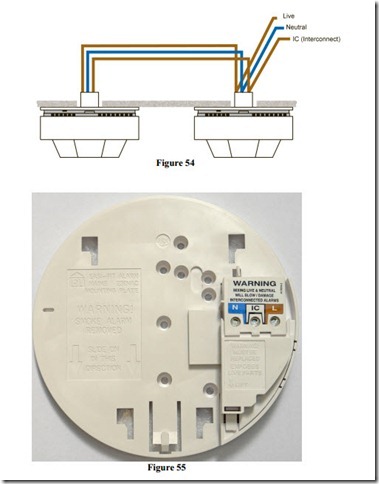In the event of a fire, the presence of smoke in escape routes ( stairways and hallways ) is the greatest problem in effecting a safe exit from a building. Smoke alarm units should be installed in these areas. Almost half of domestic fires start in kitchens. Nearby exit routes must be protected. Electrical appliances and wiring cause 15% of fires. The most common cause of fatalities involves materials used by smokers. The use of electric blankets, particularly by the elderly is another high risk situation. People with impaired mobility require more time to escape. These areas must be protected.
Alarms will only work if sleeping occupants can hear them through a closed door. For people with a severe hearing impairment, a visual alarm and under pillow vibrating disc is recommended. These can be operated by a detector unit.
Smoke Alarm Systems are classified into six grades. The most elaborate system is a Grade A, while the most basic system is a grade F.
A Grade F System consists of one or more battery operated alarm units. These are the least reliable on account of the need for the battery to be checked periodically.
A Grade E System consists of one or more mains operated units. These are reliable only if there is a very low risk of loss of mains supply.
A Grade D System consists of one or more mains operated units with battery back up supply. These are the most reliable types as the battery maintains supply in the event of mains failure.
The system recommended in domestic premises is a Grade D. There are three different types of detector.
1. Ionisation
2. Optical
3. Heat
An explanation of how they operate is beyond the scope of Phase 2.
The minimum requirement for most domestic installations is four detectors. One ionisation type fitted upstairs on the landing and one optical type fitted downstairs in the hallway.
The optical type should be used on the same floor as the kitchen. It is much less likely to be triggered by cooking operations than the ionisation type. A heat detector should be installed in the kitchen. A smoke or heat detector should be installed in the main living room. A more elaborate system may of course be installed.
Detectors should be installed in the centre of ceilings if possible. They should be at least 300 mm from any light fitting in the room. All units should be supplied directly from the same lighting circuit MCB. This is for safety reasons, as all units are interconnected. The interconnect wire should be treated as if it were a live conductor. Supplying the units from a lighting circuit automatically provides monitoring of the mains supply to them.
Units should be interconnected so that if one is triggered, all other units will alarm. Observe correct polarity of supply to all interconnected units. If polarity is wrong, damage will be done through the interconnection.
Units should not be attached to their mounting plates until all building work is completed. This is to avoid contamination by dust etc. Some manufacturers provide dust covers to overcome this problem.
N.B. Disconnect units during Insulation Resistance testing as the high test voltage will cause damage. This test is best done before the units are installed on their mounting bases.
